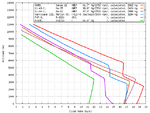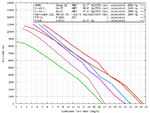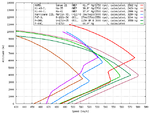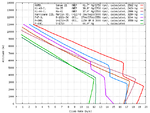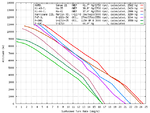Hi Claidemore,
>HoHun?? In looking at your climb rates on page 1 of this thread, you have the P40E at 16m/s at sea level (3149 ft/min). All the stats I've seen list the P40E as 2100 ft/min.
Good catch, thanks! I was still listing the P-40E at 56" Hg erreneously (as I had made a mistake modifying an existing Gnuplot script for the PTO/CBI comparison).
The curve for the P-40E at 44" Hg does in fact yield 11.22 m/s at sea level, which converts to 2209 fpm, so that it's fairly close to the 2100 fpm you expected.
>You have the F4F at 2952 ft/min and it's usually listed around 2000 ft/min.
As one or two Grumman fans have requested in other threads, I've begun to include the the lighter and better performing F4F-3 into the comparisons instead of the heavier F4F-4.
BuAer data for the F4F-4 at Military power at a weight of 7975 lbs is 2480 rpm (12.6 m/s). The lighter F4F-3 is obviously going to climb more rapidly, so my calculated 15 m/s figure looks good. Of course, if you have data specific for the F4F-3, it would be valuable for cross-checking my calculation.
Regards,
Henning (HoHun)
>HoHun?? In looking at your climb rates on page 1 of this thread, you have the P40E at 16m/s at sea level (3149 ft/min). All the stats I've seen list the P40E as 2100 ft/min.
Good catch, thanks! I was still listing the P-40E at 56" Hg erreneously (as I had made a mistake modifying an existing Gnuplot script for the PTO/CBI comparison).
The curve for the P-40E at 44" Hg does in fact yield 11.22 m/s at sea level, which converts to 2209 fpm, so that it's fairly close to the 2100 fpm you expected.
>You have the F4F at 2952 ft/min and it's usually listed around 2000 ft/min.
As one or two Grumman fans have requested in other threads, I've begun to include the the lighter and better performing F4F-3 into the comparisons instead of the heavier F4F-4.
BuAer data for the F4F-4 at Military power at a weight of 7975 lbs is 2480 rpm (12.6 m/s). The lighter F4F-3 is obviously going to climb more rapidly, so my calculated 15 m/s figure looks good. Of course, if you have data specific for the F4F-3, it would be valuable for cross-checking my calculation.
Regards,
Henning (HoHun)

